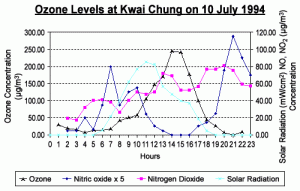Sources of Air Pollutants - Ozone and Photochemical Oxidants
Article Index
Page 5 of 7
Ozone and Photochemical Oxidants
Ozone is not a pollutant directly emitted into the air from particular activities characteristic of urban or industrial areas, and can, therefore, be referred to as a secondary pollutant. Ozone and other photochemical oxidants (such as peroxyacyl nitrates and aldehydes) are formed by the action of ultra-violet (UV) light from the sun on nitrogen oxides (a process called photolysis). Its production and concentration is dependent on the presence of primary pollutants as well as ultra-violet light. In the presence of volatile organic compounds, high concentrations of ozone are formed.
This type of pollution first gained attention during the 1940's as Los Angeles smog. Now this smog is described in terms of its photochemical oxidant composition, which includes ozone and is termed 'photochemical smog'.
Ozone and Solar Radiation
Ozone is formed primarily through the action of UV light, and so it could be expected that high concentrations would occur during the days with high solar radiation and when other meteorological conditions (e.g. low wind speed, restricted upward movement of air pollutants) are not favourable for the dispersion of air pollutants. This relationship between ozone formation and solar radiation is illustrated by the ozone levels which occurred in Kwai Chung on 10 July 1994. This can be seen in the graph below.

The diurnal variation of the pollutant levels on this very special day started off with the background levels of nitrogen oxides and ozone. Automobile and industrial activities began at around 6 am and had the initial effect of increasing the nitric oxide. The concentration decreased fairly rapidly in the morning as the high solar radiation, which intensified and peaked around 11 am, enabled the photochemical oxidation of the nitric oxide to nitrogen dioxide to occur. The concentration of nitrogen dioxide reached a peak at about 1 pm and decreased slightly in favour of ozone, which reached a peak concentration at about 2-3 pm. As the solar radiation intensity diminished in the evening, the photochemical formation of elevated air pollution level ceased and the ozone level dropped to its background concentration by about 8 pm.